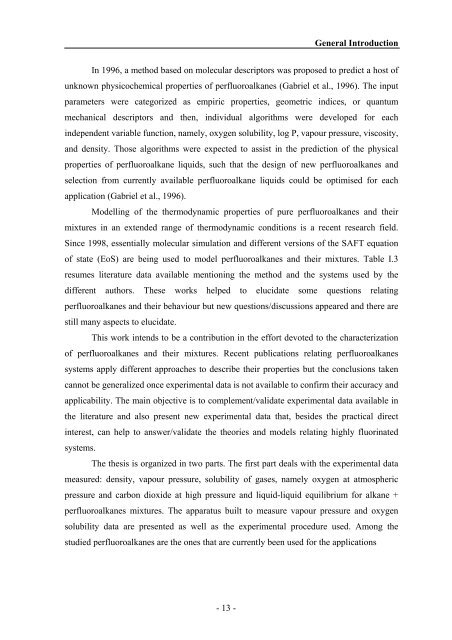n - PATh :.: Process and Product Applied Thermodynamics research ...
n - PATh :.: Process and Product Applied Thermodynamics research ...
n - PATh :.: Process and Product Applied Thermodynamics research ...
Create successful ePaper yourself
Turn your PDF publications into a flip-book with our unique Google optimized e-Paper software.
General Introduction<br />
In 1996, a method based on molecular descriptors was proposed to predict a host of<br />
unknown physicochemical properties of perfluoroalkanes (Gabriel et al., 1996). The input<br />
parameters were categorized as empiric properties, geometric indices, or quantum<br />
mechanical descriptors <strong>and</strong> then, individual algorithms were developed for each<br />
independent variable function, namely, oxygen solubility, log P, vapour pressure, viscosity,<br />
<strong>and</strong> density. Those algorithms were expected to assist in the prediction of the physical<br />
properties of perfluoroalkane liquids, such that the design of new perfluoroalkanes <strong>and</strong><br />
selection from currently available perfluoroalkane liquids could be optimised for each<br />
application (Gabriel et al., 1996).<br />
Modelling of the thermodynamic properties of pure perfluoroalkanes <strong>and</strong> their<br />
mixtures in an extended range of thermodynamic conditions is a recent <strong>research</strong> field.<br />
Since 1998, essentially molecular simulation <strong>and</strong> different versions of the SAFT equation<br />
of state (EoS) are being used to model perfluoroalkanes <strong>and</strong> their mixtures. Table I.3<br />
resumes literature data available mentioning the method <strong>and</strong> the systems used by the<br />
different authors. These works helped to elucidate some questions relating<br />
perfluoroalkanes <strong>and</strong> their behaviour but new questions/discussions appeared <strong>and</strong> there are<br />
still many aspects to elucidate.<br />
This work intends to be a contribution in the effort devoted to the characterization<br />
of perfluoroalkanes <strong>and</strong> their mixtures. Recent publications relating perfluoroalkanes<br />
systems apply different approaches to describe their properties but the conclusions taken<br />
cannot be generalized once experimental data is not available to confirm their accuracy <strong>and</strong><br />
applicability. The main objective is to complement/validate experimental data available in<br />
the literature <strong>and</strong> also present new experimental data that, besides the practical direct<br />
interest, can help to answer/validate the theories <strong>and</strong> models relating highly fluorinated<br />
systems.<br />
The thesis is organized in two parts. The first part deals with the experimental data<br />
measured: density, vapour pressure, solubility of gases, namely oxygen at atmospheric<br />
pressure <strong>and</strong> carbon dioxide at high pressure <strong>and</strong> liquid-liquid equilibrium for alkane +<br />
perfluoroalkanes mixtures. The apparatus built to measure vapour pressure <strong>and</strong> oxygen<br />
solubility data are presented as well as the experimental procedure used. Among the<br />
studied perfluoroalkanes are the ones that are currently been used for the applications<br />
- 13 -



